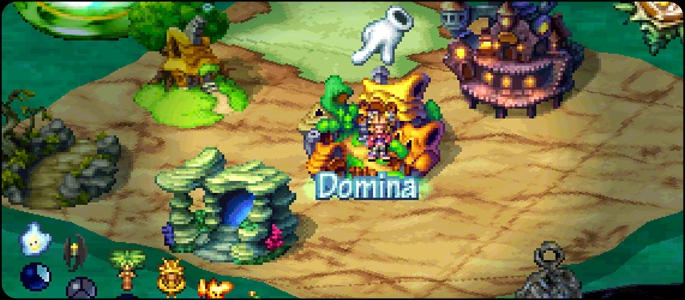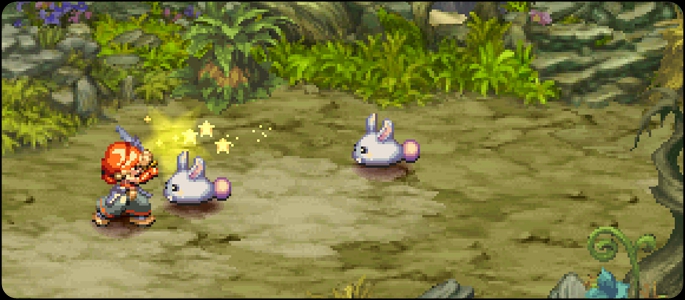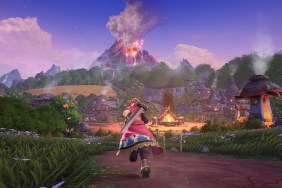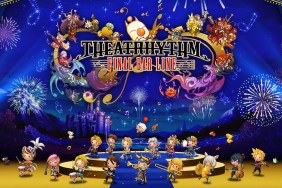You’ve got the world in your hands in Legend of Mana. That is to say, players gradually get more pieces of the world, which the game calls artifacts, and decide where on the map to put them, with a few restrictions. The term “artifacts” was chosen because each of these areas the player slaps down on the map is a remnant of the old world, before the huge war that defaced it, changing life as we know it, yet giving some hopeful game designer his big break. After being commissioned by the mana tree — now weakened by that whole apocalypse thing — the player sets out into a bleak world with the hope of steering things back towards better days.
LoM‘s mission structure scores it some portability points for those who play it on PSP. All one needs to do is follow the good old rules of walking into a given location and talking to the NPC, and the player will find himself starting up quests left and right. This hands-off approach may be seen as a breath of fresh air, but those wanting to be guided through a serious, overarching storyline need not apply. There are lots of small subplots, but there isn’t really a single main enemy that applies to the whole game, the stabbing of whom will lead one to Endcreditsville. Great for those that love some good old-fashioned non-linearity. The world in which all these quests take place enables one to quickly get addicted as well. The setup is all well and good, but it’s also just fun and interesting to explore for the sake of seeing what there is to see. This is a very fantastical world here, populated by talking teapots, various animals somehow being in the same families, and all sorts of strange things that no one in the game thinks to question. I love it. Things like this happen in other games, sure, but the extent of these goings-on in LoM is on a whole other level, for the better. It’s a fun game just to walk around in.
The dozens and dozens of smaller quests can mostly be filed into one of three main groups that forms its own path to the end. When one is finished, the player can go ahead and beat the game or try and finish the other quests. Regardless of the path the player does take, the end is the same. What’s most surprising about it all is how nonchalant the character is in all of this. Perhaps it’s made more awkward in retrospect because silent protagonists are less common nowadays than they were in LoM‘s time, but the hero/heroine watches some serious crap go down and just sort of stands idly by. I’ve heard of heroes with ‘tude but wow, for someone supposedly saving the world this guy really gives hilariously little of a crap about its people. One example from early on is just standing idly by while this nice man in Gato Grottos just gets murdered. Not like, abruptly with a headshot or anything either, it’s like, “Is that guy gonna get killed? Oh yeah it looks like the evil guy is betraying him. Yeeep, there’s the knife…aaaaand it’s in. Yeah he’s squirming. Maybe I oughtta get in there? Nah I’m just gonna keep it real over here. In the cave. Real. Holy crap that’s cold. And then the beeboppin’ music kicks back in just like it ain’t no thang that some dude is laying on the ground bleeding to death. Like whatev, right? Homie is cold, to the point it’s actually really funny to play through this story and just imagine the character as the most indifferent jackass on the planet.

Helping keep things even more enjoyable is the is truly terrific atmosphere created within Legend of Mana. Beautiful use of hand-drawn backgrounds and sprites keep this game looking stellar, even two console generations and a full decade after its initial release. The colors are vibrant and the world really looks its own; the 2D visuals here are on par with the gorgeous water color paintings found in fellow PSOne RPG, SaGa Frontier 2, also by Squaresoft. But this aesthetic splendor is enhanced all the more when Yoko Shimomura’s pleasant soundtrack comes into play. It’s not overbearing, but it is grand; not pretentious, but demanding respect. With music like this and graphics as they are, Legend of Mana is dang near timeless.
What’s far more dated is the game’s controls and combat. The same problems in this 2000 game are the same type as the ones found in its mid-1990’s Super Nintendo forefathers, except somehow worse. Players begin the game by choosing the character gender and choosing his/her main weapon from a whole host of options (dude, go for the flail). No problem there. Combat is mostly in 2D, though the player character can shuffle awkwardly up and down on the plain. OK, still not a problem necessarily. As with any decent RPG, the starter abilities are just the tip of the iceberg, and the player will come across more advanced techniques and combos as the game goes on. Still sound good so far, but then you get to actually fighting monsters and the problems immediately show themselves, and never go away. Within this 2D-trying-to-be-3D plain, the player character has to be in just exactly the perfect spot to connect with an attack. Countless times, it will look like, by all logic, swinging your sword or axe or flail will connect with the enemy in front of you. But it seems you never can be sure, as that “whiff, whiff, whiffwhiffWHIFF” sound cues up all too often. The character actually dances out his whole stinking combo, meanwhile one of the pack of monsters shifts positions and grabs himself a mouthful of gamer. Mmmmmm.
At first I thought hey, maybe I just suck at the game? So I then watched a dear friend, who holds the game as one of her favorite RPGs and has loved it since the PlayStation era, run around a bit. She still had the same problems in combat, but dismissed them because of the game’s other strengths, namely its unorthodox story and unique atmosphere. As briefly referenced above, this was a problem with the Mana games in the SNES era as well, but to see it carry on through the PlayStation times is disappointing. It doesn’t end there for the combat, though. Every character can learn special moves that power up through connecting with the enemy — and good luck with that. But hitting the button to unleash these techniques carries a stupid amount of lag, enabling enemies to sometimes hop out of the way. Dodging attacks is all well and good, and difficulty is a great thing in games, else there’d be no point to playing, but when a miss is caused by the game simply lacking polish, that’s a development flaw. And this game is loaded with them. For efficiency freaks and those who place battle system as one of an RPG’s most important aspects, Legend of Mana will not be floating your boat.

There are other control and interface issues that really make the game’s age obvious, and in fact were even kind of silly at the time. One example that jumps to mind is being automatically sent to the world map after a quest has been finished. What if I have unfinished business in this area, like I want to check out an alternate path, or do something that was right around the corner? No good, you gotta drag your ass all the way back into wherever you just were, all because you unwittingly ended a quest. A simple solution for this would have been to just ask the player “Go Home? O = Yes, X = No.” Voila! Problem solved, moderate inconvenience averted. When one of a game’s biggest strengths is its gorgeous world and fun exploration thereof, it shouldn’t make said exploration such an archaic affair. After my own playthrough, watching my aforementioned friend — a devout defender of the game — make her rounds, I asked about this as well. Her response was “Yeah it’s just programmed that way.” Yes, no crap it’s programmed that way. That’s my point; that’s my whole problem is that it’s programmed that way. It shouldn’t be.
For the nostalgic, Legend of Mana on PSN is probably a good pickup. If you played the game and liked it a decade ago, its charms still shine through today and at six dollars, it’s priced to move. As for younger gamers or those who just started playing RPGs in the mid 2000s or later, this game will probably strike as simply the standard game. The awesomeness of its top-tier atmosphere is sadly balanced out by sloppy combat and strange interface hangups, especially for an action RPG (a subgenre that generally gets these things right). Nice as it is for genre veterans (hi), the lack of a linear story will throw off some people, especially those who usually just stick to mainstream JRPGs like Final Fantasy — treasure to some and trash to others. If you liked it when it was new, or you had the best intentions to play it back then but missed out, you might as well, because you’ll certainly get lots of bang for your six bucks.
PlayStation LifeStyle’s Final Score
– Battle system is anti-fun. + Non-linear story encourages exploration. |
 |
–








